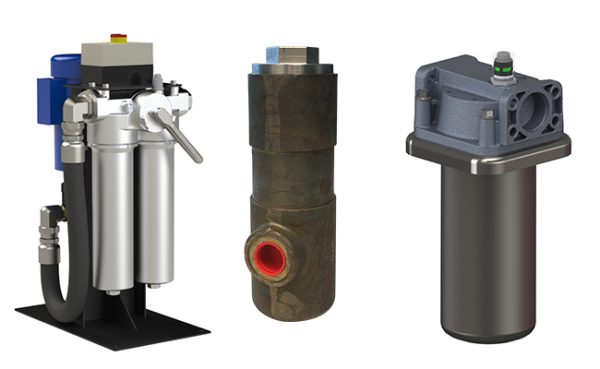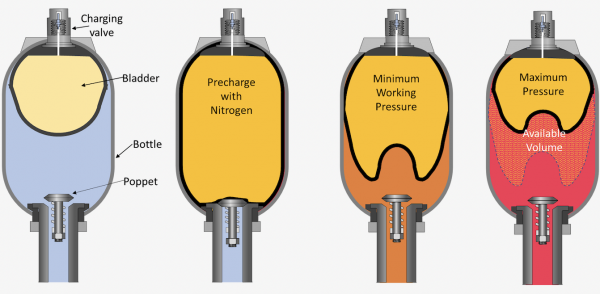The Acid Test: Judging a Hydraulic Fluid’s Performance
By Joshua Dickstein, Technology Deployment Manager – Industrial Oils, The Lubrizol Corporation.
Hydraulic fluids serve two primary functions: transmitting power and, above all else, protecting the equipment. But experienced technicians and managers understand that well-designed hydraulic fluids serve many more purposes, and the effects they can have on the bottom line are significant.
In reality, hydraulic fluids should dissipate heat, reduce friction, and prevent rust and corrosion. They must also protect against contamination and sludge buildup while minimizing thermal and oxidative degradation. As a result, lubricant manufacturers are increasingly tasked with formulating hydraulic fluids that not only serve these purposes over the short term but keep equipment functioning at peak performance over the lifetime of the fluid.
How these fluids prove their durability matters to end users, who often make decisions based on information provided by original equipment manufacturers, lubricant manufacturers, and oil marketers. Therefore, accurate tests are critical to ensuring the fluids perform as promised. Unfortunately, the historic testing regimen leaves something to be desired.
The tests that have long been the gold standard for predicting an oil’s lifetime, ASTM D943 and ASTM D4310, only tell part of the story. As equipment and operating conditions have evolved, the tests no longer paint an accurate picture of how a fluid performs in the real world. That’s why the A2F10 piston pump test has been gaining traction as a method to differentiate fluids for oil lifetime.
Designed to more accurately mimic what happens in real-world hydraulic equipment, the A2F10 test is rapidly replacing its predecessors and becoming the standard test in the industry for predicting oil drain intervals. End users are learning that they should pay closer attention to these results before making a decision about what fluid to put in their equipment to maximize their investment and protect it over the long haul.
Modern hydraulic fluids
Today’s hydraulic equipment is evolving faster than ever, which means the demands placed on hydraulic fluids are radically different than they were even a decade ago. Some of the newest requirements include:
• Efficiency. End users expect longer drain intervals and lower total cost of ownership for their equipment. That means the fluids must improve their overall efficiency to meet these goals.
• Enhanced performance. In the latest hydraulic equipment, smaller reservoirs put more strain on fluids than ever before. Today’s fluids must meet changing needs and improve performance against several new critical criteria.
• More sophisticated systems. With many applications, digitalization and automation are becoming the rule. Hydraulic fluids must now operate in more complex systems that require additional characteristics not demanded of previous fluids.
These trends mean that lubricant manufacturers must be more accurate in their testing protocols. Older testing procedures, however, don’t reflect modern operating conditions.
Traditional testing
ASTM International maintains two of the most common hydraulic fluids bench tests to see how well hydraulic fluids exhibit antioxidant properties, thus predicting the oil lifetime. ASTM D943 and ASTM D4310 are relatively inexpensive and take less time than real-world field trials.
At the time they were created, these two tests were state of the art and provided insights for end users choosing the right fluid for their application. However, for a complete picture of how fluids perform in actual equipment, both tests fall short.
ASTM D943, for example, measures oxidation potential using the change in total acid number as a guide. Unfortunately, few hydraulic fluid failures happen because of oxidation and high total acid number, which means the test is not a true indicator of real-world performance. This failure renders the test nearly meaningless as a predictor of how a fluid will actually perform.
ASTM D4310 starts to take contamination and sludge buildup into consideration by measuring the weight of insoluble material formed over 1,000 hours and the total amount of copper in the oil, water, and sludge phases. But it is still based on some of the flawed methodological shortcomings of ASTM D943. In addition, no correlation has been found between D4310 test results and oil lifetime, so it still falls short of the testing rigor necessary to provide actionable information for end users trying to choose proper hydraulic fluids.
The methodological problems and the insufficient data provided by these two legacy tests were a clear indication that a new test was necessary. In 2004, the Japanese Construction Machinery Association introduced the most up-to-date testing procedure to determine how hydraulic fluids will perform over the life of the equipment: the A2F10 piston pump test.
Advancements in A2F10
As originally conceived, the A2F10 piston pump test was not designed to measure wear protection; it solely tests the sludging, oxidation, and corrosion performance of hydraulic fluids.
Under laboratory conditions, the A2F10—a bent axis axial high-pressure piston pump—has 13 liters of hydraulic fluid circulated through it at a pressure of 5,000 psi (345 bar), a temperature of 80°C (176°F) and a speed of 1,500 rpm. In addition, 60 meters of copper catalyst are placed in the sump, and air is added to the system at a rate of 1 liter per hour to speed up oxidation.
As the test is run, researchers sample the fluids regularly (typically every 100 hours) up to 500 hours and evaluate the performance against seven different parameters. A fluid is considered a failure unless it stays within the key parameters for the entirety of the test. Engineers have determined that 500 hours in the A2F10 test accurately correlates to 2,000 hours in real-world equipment, which allows the calculation of the fluid’s oil drain interval as four times the passing hours in the test (up to 8,000 hours in the field).
Simply put, the longer a hydraulic fluid passes the A2F10 test, the longer the actual oil drain interval will be. For end users, that could lower the total cost of ownership of a piece of equipment, meaning less downtime and fewer disruptions of production schedules. As any fleet manager understands, the fewer times a machine must have its fluid changed, the more robust the bottom line.
As hydraulic equipment evolves, end users rely more on testing information provided by OEMs, lubricant manufacturers, and oil marketers when choosing fluid for their specific applications. Relying on outdated tests like the ASTM D943 and ASTM 4310 could impede their ability to make the best decisions about which hydraulic fluid will keep their equipment running at peak performance.
Fortunately, the A2F10 piston pump test more clearly mirrors real-world conditions. Though component wear is still an important consideration, measuring sludging, oxidation, and corrosion performance is equally important for modern hydraulic equipment. With this information at their fingertips, end users can decide more accurately which hydraulic fluid will keep their machines running longer and more profitably long into the future.







